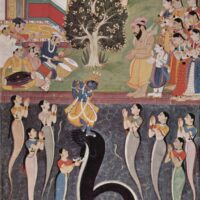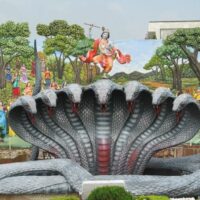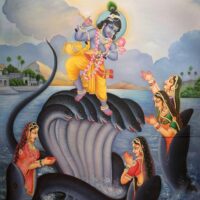Kaliya Naag : The Venemous Serpent
Listen
At a glance
| Description | |
|---|---|
| Origin | Indian Mythology |
| Classification | Animals |
| Family Members | Surasa (Wife) |
| Region | India |
| Associated With | Evil, Venom |
Kaliya Naag
Introduction
Kaliya Naag stands as one of the most feared yet fascinating figures in Hindu mythology, remembered for his confrontation with Lord Krishna during the latter’s childhood in Vrindavan. This multi-hooded serpent poisoned the sacred waters of the Yamuna, making the river unfit for life and casting fear over the region. The famous episode, known as Kaliya Mardan, is not just a tale of divine triumph but also a symbolic lesson on the nature of evil, redemption, and the transformative power of compassion. Kaliya’s story continues to be celebrated in Vaishnavite traditions, temple rituals, dance dramas, and cultural retellings, highlighting his place as a central figure in the mythic landscape of India.
Physical Traits
Descriptions of Kaliya Naag vary, but he is consistently portrayed as a colossal serpent with multiple hoods—some texts say five, while others expand the number into the hundreds or even a thousand. His immense size, dark shimmering scales, and venomous presence turned the waters of the Yamuna into a deadly expanse that boiled with poison. Birds dropped from the skies, fish perished instantly, and even the air grew noxious around him. His hoods radiated both terror and majesty, and when Krishna subdued him, each divine step upon those hoods symbolized the crushing of arrogance and malevolence, transforming the poisonous energy into submission.
Family
Kaliya Naag belonged to the ancient lineage of Nagas, serpent beings born of Kadru and Sage Kashyapa. This illustrious family included other well-known Nagas such as Shesha, Vasuki, Takshaka, and Manasa, each of whom played important roles in Indian mythology. Kaliya’s consort, often named Surasa, and his wives feature prominently in the tale, as it was their heartfelt pleas that moved Krishna to spare Kaliya’s life after the fierce encounter. Their intercession illustrates a deeper truth within the story: compassion often flows through family bonds, and even the most venomous being has the potential for redemption when grace is extended.
Other names
While most texts and traditions refer to him simply as Kaliya or Kaliya Naag, variations of his name appear across regions. Some sources call him Kāliya, others refer to him as the Yamuna Serpent, linking his identity directly to the river he poisoned. These titles emphasize different facets of his character—his serpent form, his connection with darkness (kāla meaning black or time), and his role as the great adversary subdued by Krishna. The episode also gave Krishna the epithet Kaliya Nartana Krishna, meaning the one who danced upon Kaliya’s hoods, a name that continues to be used in devotional songs and temple art.
Powers and Abilities
The powers of Kaliya Naag made him a terrifying presence in the Yamuna. His venom was so potent that it poisoned miles of water, turning a sacred river into a lifeless zone. His immense strength allowed him to coil around adversaries with crushing force, even momentarily overpowering Krishna before the divine child revealed his true power. Some traditions suggest he possessed the ability to manipulate water currents and create illusions, adding to his fearsome reputation. His greatest act of survival, however, was escaping Garuda, the eagle mount of Vishnu and eternal enemy of serpents. Driven from his home on Ramanaka Island by Garuda’s attacks, Kaliya found refuge in Vrindavan, as Garuda had been cursed never to enter that region. This twist of fate allowed him to settle in the Yamuna, but also led to his fateful confrontation with Krishna.
Modern Day Influence
The legend of Kaliya Naag has not faded with time; instead, it continues to resonate in both religious and cultural spaces. In Vrindavan, the Naga Nathaiya festival reenacts Krishna’s dance on the serpent’s hoods, performed through classical dance forms such as Manipuri and Kathak. This celebration is a visual reminder of the power of divinity to subdue negativity. Artists across centuries—from temple sculptors to modern digital illustrators—have depicted the dramatic scene of Krishna standing triumphantly upon Kaliya’s heads, flute in hand, radiating serenity amidst chaos.
Beyond art and festivals, the story is often interpreted symbolically in philosophy and psychology. Kaliya Naag is seen as a representation of inner toxins—anger, jealousy, pride, and hatred—that can cloud the human mind just as his venom polluted the Yamuna. Krishna’s subduing of Kaliya serves as a metaphor for spiritual discipline and divine guidance cleansing the soul of destructive tendencies. Children’s literature, comics, and animations retell the episode as a moral story, teaching the importance of humility, surrender, and trust in divine wisdom.
Interestingly, the serpent’s symbolism is not confined to Indian traditions alone. The imagery of a divine figure crushing or overcoming a serpent appears in other cultures as well—such as Christian depictions of Jesus defeating the serpent of Eden. These parallels highlight how universal the themes of good overcoming evil and compassion triumphing over destruction truly are.
Kaliya Naag’s tale also reminds us that redemption is possible even for the most feared beings. Krishna did not slay Kaliya but chose to spare him after his wives’ prayers, sending him away with the promise that Garuda would no longer trouble him. This act of mercy continues to inspire teachings on forgiveness, transformation, and the idea that divine grace is available to all, no matter how far they have strayed.
Related Images
Source
Hindu Blog. (2016). Story of Sri Krishna and Kaliya Mardan. Retrieved from https://www.hindu-blog.com/2016/01/krishna-and-kaliya-naag-story-of-sri.html
AstroCulture. (n.d.). Why Krishna Spared Kaliya Naag’s Life. Retrieved from https://www.astroculture.in/blog/why-krishna-did-not-kill-the-cruel-kaliya-naag/
Wisdom Library. (n.d.). Serpent Kaliya: Significance and symbolism. Retrieved from https://www.wisdomlib.org/concept/serpent-kaliya
Wikipedia. (n.d.). Kaliya. Retrieved from https://en.wikipedia.org/wiki/Kaliya
Bagga, H. (n.d.). Why Krishna did not kill the cruel Kaliya Naag Story. Retrieved from https://hanishbagga.com/story/kaliya-naag-story/
Sanskriti Magazine. (n.d.). The Kaliya Naag and Sri Krishna – The Hidden Meaning. Retrieved from https://www.sanskritimagazine.com/kaliya-naag-sri-krishna-hidden-meaning/
Frequently Asked Questions
What is lorem Ipsum?
I am text block. Click edit button to change this text. Lorem ipsum dolor sit amet, consectetur adipiscing elit. Ut elit tellus, luctus nec ullamcorper mattis, pulvinar dapibus leo.
What is lorem Ipsum?
I am text block. Click edit button to change this text. Lorem ipsum dolor sit amet, consectetur adipiscing elit. Ut elit tellus, luctus nec ullamcorper mattis, pulvinar dapibus leo.
What is lorem Ipsum?
I am text block. Click edit button to change this text. Lorem ipsum dolor sit amet, consectetur adipiscing elit. Ut elit tellus, luctus nec ullamcorper mattis, pulvinar dapibus leo.
What is lorem Ipsum?
I am text block. Click edit button to change this text. Lorem ipsum dolor sit amet, consectetur adipiscing elit. Ut elit tellus, luctus nec ullamcorper mattis, pulvinar dapibus leo.
What is lorem Ipsum?
I am text block. Click edit button to change this text. Lorem ipsum dolor sit amet, consectetur adipiscing elit. Ut elit tellus, luctus nec ullamcorper mattis, pulvinar dapibus leo.













Murl Blick
Simply desire to say your article is as surprising The clearness in your post is simply excellent and i could assume you are an expert on this subject Fine with your permission let me to grab your feed to keep up to date with forthcoming post Thanks a million and please carry on the gratifying work
Jana MacGyver
Your blog is a treasure trove of valuable insights and thought-provoking commentary. Your dedication to your craft is evident in every word you write. Keep up the fantastic work!
Eudora Kiehn
Your blog is a constant source of inspiration for me. Your passion for your subject matter is palpable, and it’s clear that you pour your heart and soul into every post. Keep up the incredible work!